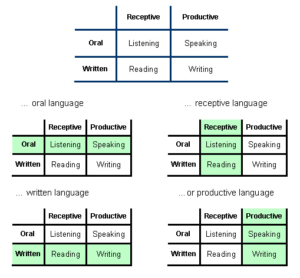The Common Core State Standards (CCSS) created grade-specific standards to ensure each student is comprehending the skills and knowledge they’re learning each year. The Common Core establishes standards in English Language Arts/Literacy (ELA) and mathematics.
The three sections of the CCSS are divided into strands centered around the College and Career Readiness Anchor Standards (CRR). There’s one K-5 section and two 6-12 content-focused sections. The first 6-12 section is for ELA and the other section is dedicated to more technical subjects such as science or social studies. More on the CCSS organization can be found on their website here.
The K-5 and 6-12 ELA sections have four strands:
- Reading
- Writing
- Speaking and Listening
- Language
These standards provide students and educators the information and resources necessary for students to succeed in their future academic career and life.
How Standards Benefits Teachers
The CCSS outlines and communicates student learning expectations at each grade level, allowing students, parents, teachers, and school administrators to collectively be on the same page with students’ academic comprehension. The standards also provide teachers a big-picture image of what they need to accomplish in a given year, which helps with yearly lesson planning.
Established standards also allow for educators to work closely together with outside support, such as tutors, toward the shared goals.
Standard 1: Reading
Text Complexity and Growth of Comprehension
The reading standards offer year by year instruction for educators to ensure that students are exposed to a diverse range of texts that continually increase in complexity. Not only do students need to be able to read more complex texts, but they also need to comprehend texts at a deeper level. This means: fully understanding the text, making deeper connections, drawing themes or meanings, and finding key ideas.
Learn Alberta also indicates how reading comprehension is an intersection of receptive and written skills. The key to helping students master it is making sure they are retaining knowledge from written works, rather than just being able to repeat it back.

Image from Learn Alberta
Our tip for educators: To make sure your students are deeply understanding what they’re reading, ask them to reflect on the text afterwards. Here are 10 creative ways to check for student comprehension.
Standard 2: Writing
Text Types, Reading Response, and Research
By the same chart, the writing strand of English learning is defined as productive reading. Meaning that for a student to be considered proficient at writing, they need to have the “ability to plan, revise, edit, and publish” their work.
Mastery of this takes continued practice. This practice can look like a consistent variation of writing prompts that challenges students to keep thinking of new things to learn to write. In many cases, this can be better and faster done with online exercises such as spelling and grammar games.
Our tip for educators: Writing lessons will be crucial to the development of this strand, but just like math problems, much of the understanding will take place in practice. Additional support from tutoring programs that can help students in smaller group settings and can help further student comprehension levels.
Standard 3: Speaking and Listening
Flexible Communication and Collaboration
Speaking goes hand-in-hand with listening. The speaking and listening strand is all about communication and collaboration. It’s assessed by students’ ability to recognize messages that are being conveyed to them and form thoughts and opinions in response. This has been time and time proven by mere exposure. For example, many high school students looking to learn a new language opt to stay with a host family abroad to immerse themselves in the language.
The CCSS requires educators to immerse students in a diverse range of oral and visual texts to develop communication and interpersonal skill sets.
Our tip for educators: Expose students to various texts and ask them to collaboratively evaluate what they’re hearing.
Standard 4: Language
Conventions, Effective Use, & Vocabulary
This standard breaks down the key principles of written and spoken English. As a student progresses each year, they’re expected to have increasingly sophisticated writing and speaking skills. The CCSS language progressive skills include punctuation, verb tense, maintaining consistency in style and tone.
Our tip for educators: With concepts such as punctuation or pronouns, on-text practice sheets can help a student visually and it’s easier to grasp these concepts quicker. For students whose first language isn’t English, tutoring services such as Intervene K-12 that provide English Learner Support can help English Language Learners (ELs) keep up with their classmates.
Intervene K-12 as a Solution
Intervene K-12 offers online tutoring services to help K-12 students succeed with ELA standards. Our programs offer small group tutoring sessions for school districts that align directly with classroom instruction material. In addition, our SaaS platform specifically helps students learn English and practice for standardized tests using speaking, listening, reading and writing. Students can further their comprehension in-school with access to a computer, headset and a microphone!
Learn more at https://intervenek12.com/